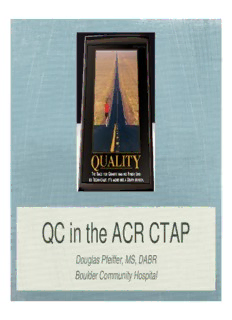
QC in the ACR CTAP PDF
Preview QC in the ACR CTAP
QC in the ACR CTAP Douglas Pfeiffer, MS, DABR Boulder Community Hospital Introduction QC is essential for the consistent production of quality images Documentation is essential Active, not passive Does not need to be time-consuming Manufacturer Programs Manufacturers required to provide QC phantom and recommendations [21 CFR Ch. 1 §1020.33(d)] Contrast scale Noise Nominal tomographic section thickness Spatial resolution - high and low contrast Mean CT number - water or reference material The Rest Might Be A Lie! Renovated CT Submission CTAP submission WILL be changed Streamlined process No alignment test No reconstructed scan width test Scan phantom using clinical protocols Adult head, abdomen Pediatric head, abdomen Renovated CT Submission Streamlined process… Submit DICOM data on CD MRI model For now, dosimetry will remain the same Low contrast transitioning to CNR Spatial resolution going away Siemens Measures Slice position Slice thickness CT number homogeneity Noise Water CT number MTF Table positioning After alignment, scanner automatically scans phantom, computes, logs data General Electric Measures Slice position Slice thickness Spatial resolution Low contrast Noise Water CT number Manual scan, calculation, documentation Philips Measures Slice Thickness Noise & Uniformity “Impulse Response” (MTF) Contrast Scale Low Contrast Detectability Spatial Measurement Accuracy Manual scan of each module, automated analysis Toshiba Multiple phantoms Measure Slice Thickness Noise & Uniformity “Impulse Response” (MTF) Contrast Scale Low Contrast Detectability Spatial Measurement Accuracy Manual scan, manual analysis
Description: